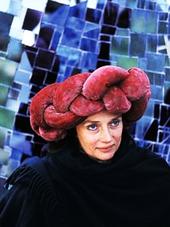Niki de Saint Phalle, born Catherine-Marie-Agnès Fal de Saint Phalle (October 29, 1930) is a French sculptor, painter, and film maker.Niki de Saint Phalle was born in Neuilly-sur-Seine, Hauts-de-Seine near Paris, to Jeanne Jacqueline (née Harper) and André-Marie Fal de Saint Phalle, a banker. After being wiped out financially during the Great Depression, the family moved from France to the United States in 1933. During her teens, she was a fashion model; at the age of sixteen she made the cover of Life magazine (September 26, 1949), and later the November 1952 cover of the French Vogue magazine. At eighteen, de Saint Phalle eloped with author Harry Mathews, whom she had known since the age of twelve, and moved to Cambridge, Massachusetts. While her husband studied music at Harvard University, de Saint Phalle began to paint, experimenting with different media and styles. Their first child, Laura, was born in 1951.De Saint Phalle rejected the staid, conservative values of her family, which dictated domestic positions for wives and particular rules of conduct. However, after marrying young and giving birth to two children, she found herself living the same bourgeois lifestyle that she had attempted to reject; the internal conflict led to her to suffer a nervous breakdown. As a form of therapy, she was encouraged to start painting.While in Paris, de Saint Phalle was introduced to the American painter Hugh Weiss who became both her friend and mentor, encouraging her to continue painting in her self-taught style. She subsequently moved to Deya, Majorca, Spain where her son Philip was born in May of 1955. While in Spain, de Saint Phalle read the works of Proust and visited Madrid and Barcelona where she discovered and was deeply affected by the work of Antonio GaudÃ. GaudÃ's influence opened many previously unimagined possibilities for de Saint Phalle regarding the use of diverse material and objet-trouvés as structural elements in sculpture and architecture. De Saint Phalle was particularly struck by GaudÃ's "Park Güell" which convinced her to one day create her own garden work that would combine both art and nature. Saint Phalle continued to paint, particularly after her family relocated to Paris in the mid-1950s. Her first art exhibition was held in 1956 in Switzerland where she displayed naïve style oil paintings. She then moved onto collage work that often featured objects of violence, such as guns and knives.After the "Shooting paintings" came a period when she explored the various roles of woman. She made life size dolls of women, such as brides and mothers giving birth. They were usually dressed in white. They were primarily made of polyester with a wire framework. They were generally created from papier mâché.Inspired by the pregnancy of her friend Clarice Rivers, the wife of American artist Larry Rivers, she began to use her artwork to consider archetypal female figures in relation to her thinking on the position of women in society. Her artistic expression of the proverbial everywoman were named 'Nanas'. The first of these freely posed forms, made of papier-mâché, yarn, and cloth were exhibited at the Alexander Iolas Gallery in Paris in September of 1965. For this show, Iolas published her first artist books that includes her handwritten words in combination with her drawings of 'Bananas'. Encouraged by Iolas, she started a highly productive output of graphic work that accompanied exhibitions that included posters, books and writings.In 1966, she collaborated with fellow artist Jean Tinguely and Per Olof Ultvedt on a large scale sculpture installation, "hon-en katedral" ("she-a cathedral") . for Moderna Museet, Stockholm, Sweden. The outer form of "hon" is a giant, reclining 'Nana', whose internal environment is entered from between her legs. The piece elicited immense public reaction in magazines and newspapers throughout the world. The interactive quality of the "hon" combined with a continued fascination with fantastic types of architecture intensifies her resolve to see her own architectural dreams realized. During the construction of the "hon-en katedral," she met Swiss artist Rico Weber, who became an important assistant and collaborator for both de Saint Phalle and Jean Tinguely. During the 1960s, she also designed decors and costumes for two theatrical productions: a ballet by Roland Petit, and an adaptation of the Aristophanes play "Lysistrata."In 1955 de Saint Phalle met Jean Tinguely and his wife, Eva Aeppli. She asked Tinguely to weld the armature for her first sculpture. In 1960, de Saint Phalle divorced her husband and that same year, Jean Tinguely and Eva Aeppli also divorced. De Saint Phalle and Tinguely subsequently moved into the Impasse Ronsin where they shared the same studio and lived surrounded by other artists, including Constantin Brancusi. It was in this period that Marcel Duchamp introduced the pair to the Spanish surrealist Salvador DalÃ. De Saint Phalle later traveled to Spain with Tinguely in order to attend a celebration honoring DalÃ; while there, the pair created a life-sized exploding bull with plaster, paper and fireworks for the arena at Figueras. In 1963, they bought an old country inn outside of Paris to serve as both their home and studio, l'Auberge du Cheval Blanc in Soisy-sur-École, some 50 kilometers south of Paris. She married Jean Tinguely on 15 July 1971, thereby potentially acquiring Swiss citizenship.Influenced by GaudÃ..s Parc Güell in Barcelona, and the garden in Bomarzo, de Saint Phalle decided that she wanted to make something similar; a monumental sculpture park created by a woman. In 1979, she acquired some land in Garavicchio, Tuscany, about 100 km north-west of Rome along the coast. The garden, called Giardino dei Tarocchi in Italian, contains sculptures of the symbols found on Tarot cards. The garden took many years, and a considerable sum of money, to complete. It opened in 1998, after more than 20 years of work.
www.NikiDeSaintPhalle.com
